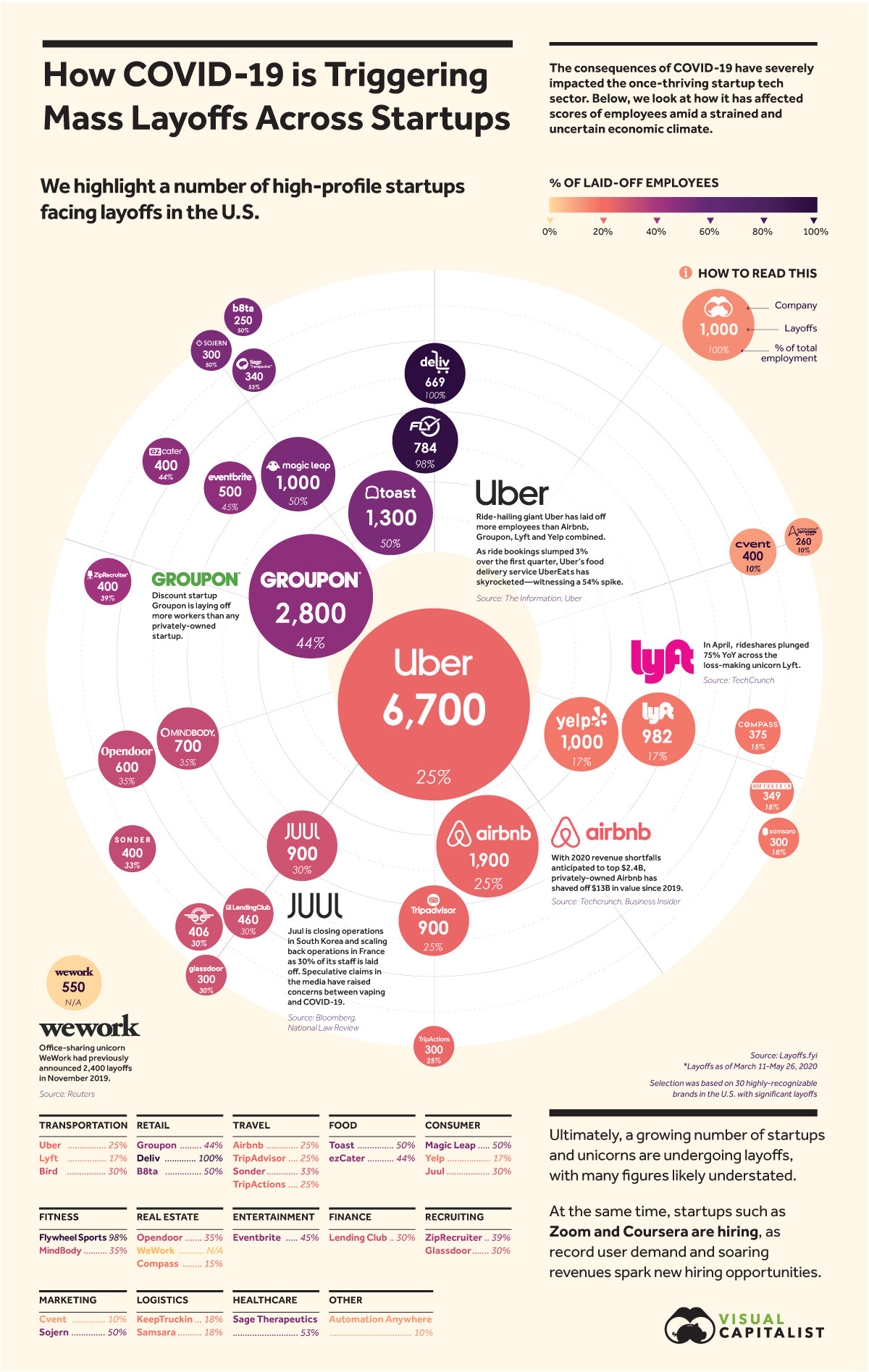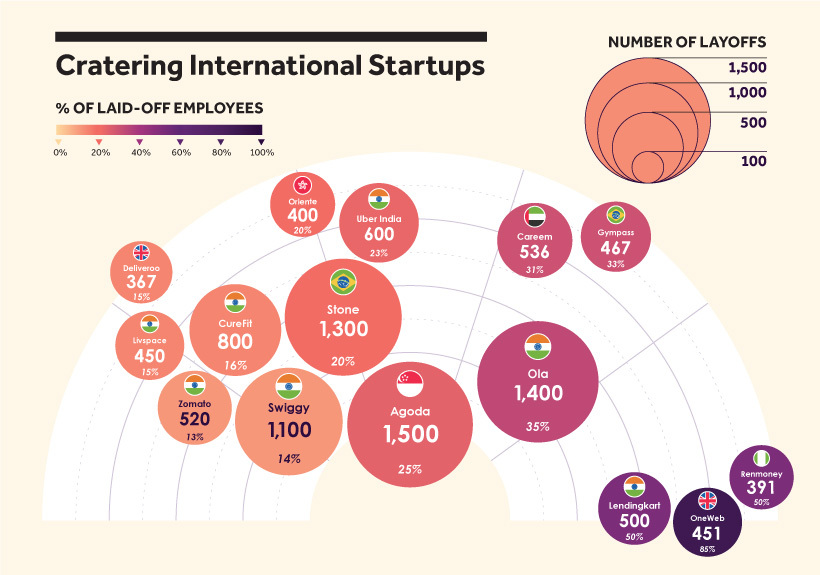Economy
Visualizing Layoffs at Prominent Startups Triggered by COVID-19

Layoffs at Prominent Startups Triggered by COVID-19
As the pandemic reverberates through almost every industry imaginable, tech startups are also feeling the pain.
Since mid-March, countless startups and unicorns have undergone layoffs.
Today’s infographic pulls data from Layoffs.fyi, and navigates the cascading layoffs across 30 of the most recognizable startups in America. Each of the companies have slashed over 250 employees between March 11 and May 26, 2020—capturing a snapshot of the continuing fallout of COVID-19.
Silicon Valley Takes a Hit
Unsurprisingly, many of the hardest hit startups are related to the travel and mobility industry.
Closing 45 offices, Uber has laid off 6,700 employees since mid-March. Uber CEO Dara Khosrowshahi, who was granted a $45M earnings package in 2018, announced he will also waive his $1M base salary for the remainder of the year.
| Company | # Layoffs | % of Employees | Industry |
|---|---|---|---|
| Uber | 6,700 | 25% | Transportation |
| Lyft | 982 | 17% | Transportation |
| Bird | 406 | 30% | Transportation |
| Airbnb | 1,900 | 25% | Travel |
| TripAdvisor | 900 | 25% | Travel |
| Sonder | 400 | 33% | Travel |
| TripActions | 300 | 25% | Travel |
| Magic Leap | 1,000 | 50% | Consumer |
| Yelp | 1,000 | 17% | Consumer |
| Juul | 900 | 30% | Consumer |
| Groupon | 2,800 | 44% | Retail |
| Deliv | 669 | 100% | Retail |
| B8ta | 250 | 50% | Retail |
| Toast | 1,300 | 50% | Food |
| ezCater | 400 | 44% | Food |
| Flywheel Sports | 784 | 98% | Fitness |
| MindBody | 700 | 35% | Fitness |
| Opendoor | 600 | 35% | Real Estate |
| WeWork | 550 | N/A | Real Estate |
| Compass | 375 | 15% | Real Estate |
| ZipRecruiter | 400 | 39% | Recruiting |
| Glassdoor | 300 | 30% | Recruiting |
| Cvent | 400 | 10% | Marketing |
| Sojern | 300 | 50% | Marketing |
| KeepTruckin | 349 | 18% | Logistics |
| Samsara | 300 | 18% | Logistics |
| Eventbrite | 500 | 45% | Entertainment |
| Lending Club | 460 | 30% | Finance |
| Sage Therapeutics | 340 | 53% | Healthcare |
| Automation Anywhere | 260 | 10% | Other |
*Layoffs reported between March 11-May 26, 2020
Meanwhile, as room bookings dropped by over 40% across several countries, Airbnb laid off a quarter of its workforce. The tech darling is anticipating a $2.4B revenue shortfall in 2020.
Like many other big names—including Lyft, Uber, and WeWork—Airbnb is struggling to achieve profitability. In the first nine months of 2019, it lost $322M at the height of the market cycle.
Until 2021, gig-economy revenues are projected to drop by at least 30%.
International Startups Struggling
Startups in the U.S. aren’t the only ones scrambling to conserve cash and cut costs.
Brazil-based unicorn Stone has let go of 20% of its workforce. The rapidly growing digital payments company includes Warren Buffett as a major stakeholder, holding an 8% share as of March 2020.

At the same time, India-based ride-hailing Ola has witnessed revenue declines of 95% since mid-March. It laid off 1,400 employees as bookings drastically declined.
| Company | # Layoffs | % of Employees | Location |
|---|---|---|---|
| Swiggy | 1,100 | 14% | India |
| Agoda | 1,500 | 25% | Singapore |
| Ola | 1,400 | 35% | India |
| Stone | 1,300 | 20% | Brazil |
| CureFit | 800 | 16% | India |
| Uber India | 600 | 23% | India |
| Careem | 536 | 31% | U.A.E. |
| Zomato | 520 | 13% | India |
| Lendingkart | 500 | 50% | India |
| Gympass | 467 | 33% | Brazil |
| OneWeb | 451 | 85% | United Kingdom |
| Livspace | 450 | 15% | India |
| Oriente | 400 | 20% | Hong Kong |
| Renmoney | 391 | 50% | Nigeria |
| Deliveroo | 367 | 15% | United Kingdom |
Similarly, Uber India has rivaled Ola in dominance across India’s $10B ride-hailing market since launching three years after Ola, in 2013. Now, almost 25% of the Uber India workforce have been laid off.
Of course, these reports do not fully take into account the growing impact of COVID-19, but help paint a picture as the cracks emerge.
Pandemic-Proof?
While the job market remains murky, what startups are looking to hire?
Coursera, an online education startup, listed 60 openings in May. By the end of the year, the company plans to hire 250 additional staff. Within the peak of widespread global lockdowns, the platform attracted 10M new users.
Meanwhile, Canva, an Australia-based graphic design unicorn, is seeking to fill 100 positions worldwide. In partnership with Google for Education, Canva offers project-based learning tools designed for classrooms, in addition to free graphic design resources.
At the same time, tech heavyweights Facebook and Amazon reported openings. Booming startups such as Plaid, Zoom, and Pinterest are also listing new positions as shifting consumer demand continues to shape unpredictable and historic hiring markets.
Copper
Brass Rods: The Secure Choice
This graphic shows why brass rods are the secure choice for precision-machined and forged parts.

Brass Rods: The Secure Choice
The unique combination of machinability and recyclability makes brass rods the secure choice for manufacturers seeking future-proof raw material solutions.
This infographic, from the Copper Development Association, shows three ways brass rods give manufacturers greater control and a license to grow in the competitive market for precision-machined and forged products.
Future-Proof Investments in New Machine Tools
A material’s machinability directly impacts machine throughput, which typically has the largest impact on machine shop profitability.
The high-speed machining capabilities of brass rods maximize machine tool performance, allowing manufacturers to run the material faster and longer without sacrificing tool life, chip formation, or surface quality.
The high machining efficiency of brass leads to reduced per-part costs, quicker return on investment (ROI) for new machine tools, and expanded production capacity for new projects.
Supply Security Through Closed Loop Recycling
Brass, like its parent element copper, can be infinitely recycled.
In 2022, brass- and wire-rod mills accounted for the majority of the 830,000 tonnes of copper recycled from scrap in the United States.
Given that scrap ratios for machined parts typically range from 60-70% by weight, producing mills benefit from a secure and steady supply of clean scrap returned directly from customers, which is recycled to create new brass rods.
The high residual value of brass scrap creates a strong recycling incentive. Scrap buy back programs give manufacturers greater control over raw material net costs as scrap value is often factored into supplier purchase agreements.
Next Generation Alloys for a Lead-Free Future
Increasingly stringent global regulations continue to pressure manufacturers to minimize the use of materials containing trace amounts of lead and other harmful impurities.
The latest generation of brass-rod alloys is engineered to meet the most demanding criteria for lead leaching in drinking water and other sensitive applications.
Seven brass-rod alloys passed rigorous testing to become the only ‘Acceptable Materials’ against lower lead leaching criteria recently adopted in the national U.S. drinking water quality standard, NSF 61.

Learn more about the advantages of brass rods solutions.

-

 Base Metals1 year ago
Base Metals1 year agoRanked: The World’s Largest Copper Producers
Many new technologies critical to the energy transition rely on copper. Here are the world’s largest copper producers.
-

 Silver2 years ago
Silver2 years agoMapped: Solar Power by Country in 2021
In 2020, solar power saw its largest-ever annual capacity expansion at 127 gigawatts. Here’s a snapshot of solar power capacity by country.
-

 Batteries5 years ago
Batteries5 years agoVisualizing Copper’s Role in the Transition to Clean Energy
A clean energy transition is underway as wind, solar, and batteries take center stage. Here’s how copper plays the critical role in these technologies.
-

 Science5 years ago
Science5 years agoEverything You Need to Know on VMS Deposits
Deep below the ocean’s waves, VMS deposits spew out massive amounts of minerals like copper, zinc, and gold, making them a key source of the metals…
-

 Copper5 years ago
Copper5 years agoHow Much Copper is in an Electric Vehicle?
Have you ever wondered how much copper is in an electric vehicle? This infographic shows the metal’s properties as well as the quantity of copper used.
-

 Copper6 years ago
Copper6 years agoCopper: Driving the Green Energy Revolution
Renewable energy is set to fuel a new era of copper demand – here’s how much copper is used in green applications from EVs to photovoltaics.
-

 Green2 weeks ago
Green2 weeks agoRanked: Top Countries by Total Forest Loss Since 2001
-

 Travel1 week ago
Travel1 week agoRanked: The World’s Top Flight Routes, by Revenue
-

 Technology1 week ago
Technology1 week agoRanked: Semiconductor Companies by Industry Revenue Share
-

 Money2 weeks ago
Money2 weeks agoWhich States Have the Highest Minimum Wage in America?
-

 Real Estate2 weeks ago
Real Estate2 weeks agoRanked: The Most Valuable Housing Markets in America
-

 Markets2 weeks ago
Markets2 weeks agoCharted: Big Four Market Share by S&P 500 Audits
-

 AI2 weeks ago
AI2 weeks agoThe Stock Performance of U.S. Chipmakers So Far in 2024
-

 Automotive2 weeks ago
Automotive2 weeks agoAlmost Every EV Stock is Down After Q1 2024

 Can I share this graphic?
Can I share this graphic? When do I need a license?
When do I need a license? Interested in this piece?
Interested in this piece?
















